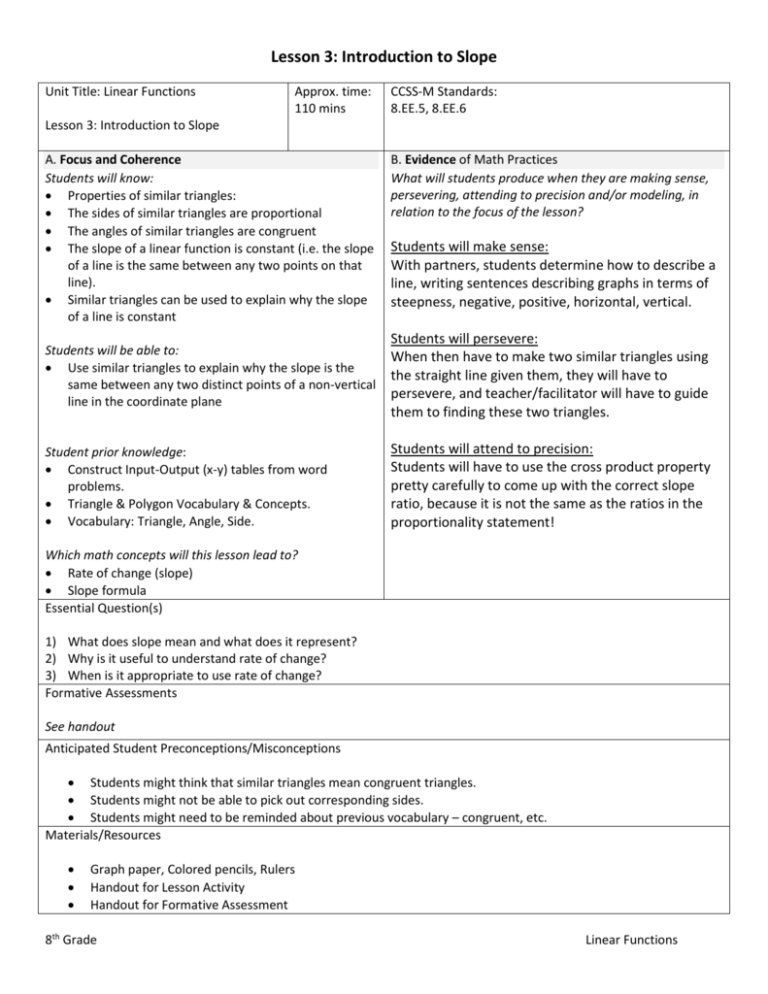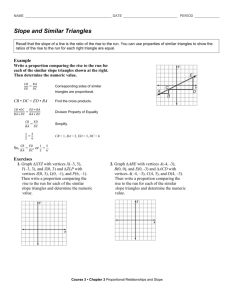8.Linear Functions Lesson 3
advertisement

Lesson 3: Introduction to Slope Unit Title: Linear Functions Approx. time: 110 mins CCSS-M Standards: 8.EE.5, 8.EE.6 Lesson 3: Introduction to Slope A. Focus and Coherence Students will know: Properties of similar triangles: The sides of similar triangles are proportional The angles of similar triangles are congruent The slope of a linear function is constant (i.e. the slope of a line is the same between any two points on that line). Similar triangles can be used to explain why the slope of a line is constant B. Evidence of Math Practices What will students produce when they are making sense, persevering, attending to precision and/or modeling, in relation to the focus of the lesson? Students will make sense: With partners, students determine how to describe a line, writing sentences describing graphs in terms of steepness, negative, positive, horizontal, vertical. Students will be able to: Use similar triangles to explain why the slope is the same between any two distinct points of a non-vertical line in the coordinate plane Students will persevere: When then have to make two similar triangles using the straight line given them, they will have to persevere, and teacher/facilitator will have to guide them to finding these two triangles. Student prior knowledge: Construct Input-Output (x-y) tables from word problems. Triangle & Polygon Vocabulary & Concepts. Vocabulary: Triangle, Angle, Side. Students will attend to precision: Students will have to use the cross product property pretty carefully to come up with the correct slope ratio, because it is not the same as the ratios in the proportionality statement! Which math concepts will this lesson lead to? Rate of change (slope) Slope formula Essential Question(s) 1) What does slope mean and what does it represent? 2) Why is it useful to understand rate of change? 3) When is it appropriate to use rate of change? Formative Assessments See handout Anticipated Student Preconceptions/Misconceptions Students might think that similar triangles mean congruent triangles. Students might not be able to pick out corresponding sides. Students might need to be reminded about previous vocabulary – congruent, etc. Materials/Resources Graph paper, Colored pencils, Rulers Handout for Lesson Activity Handout for Formative Assessment 8th Grade Linear Functions C. Rigor: fluency, deep understanding, application and dual intensity What are the learning experiences that provide for rigor? What are the learning experiences that provide for evidence of the Math Practices? (Detailed Lesson Plan) Warm Up 1) Sam is going to the State Fair and he wants to find out how much he will pay for 6 hot dogs at the State Fair. Complete the table and find out how much he needs to pay. Hog dogs purchased How much he will pay 0 0 1 $2 2 $4 3 $6 4 5 6 2) Are the two fractions the same? 1 2 3 6 How do you know? 3) Solve for x: 2 x 3 6 4) Solve for x: 3 7 5 x 5) Show the similar sides of each pair of triangles by highlighting the similar sides with the same color. a) b) Lesson New Vocabulary – Similar Polygon, Similar Triangle, Definition, Property, Corresponding Angles, Corresponding Sides, Scale Factor, Proportionality Statement, Similarity Statement Prior Vocabulary – Polygon, Triangle, Angle, Side, Proportional, Cross Product Property, Multiplication Property of Equality, Congruent Input: Introductory Message This lesson is going to be about geometry, because I need you to understand why the slope of a line is constant. We will be using properties of similar triangles to help you understand this. 8th Grade Linear Functions Activity 1 (Direct Instruction) There are several different looking lines on the coordinate planes (6) you have been given. Talk to your partners and give the most accurate description of each graph in one or two sentences. (No need to get feedback) 1. Give students the definition of similar triangles. (Congruent angles & Proportional Sides) 2. Explain proportional sides by asking them to shade 2 pairs of corresponding sides with matching colors. (2 colored pencils for each student.) 3. Write proportionality statement using the colored pairs of sides. 4. Draw a graph using a table of values. 5. Draw 2 similar right triangles. 6. Extract them and draw them separately. 7. Write a proportionality statement y 8. Use the cross product property to write a different proportion that represents or change in output x divided by change in input. 9. Ask students what they notice. Students should notice that these represent the same amount. Activity 2 (Non-Direct Instruction – Alternative to Activity 1) There are several different looking lines on the coordinate planes (6) you have been given. Talk to your partners and give the most accurate description of each graph in one or two sentences. (No need to get feedback) Part 1 – Similar Triangles 1. Give students the definition of similar triangles. (Congruent angles & Proportional Sides) 2. Explain proportional sides by asking them to shade 2 pairs of corresponding sides with matching colors. (2 colored pencils for each student.) 3. Write proportionality statement using the colored pairs of sides. Part 2 – Graphs & Similar Triangles 4. Present a word problem such as: Anna saves $60 from January through March and $120 from April through September. 5. Asks students to present this situation using a table and a graph. 6. Ask students to create two triangles using points on the graph. 7. Ask students to discuss and then share out to class why the triangles are similar. 8. Ask them to write proportionality statements. 9. Ask them if the proportionality statement can be re-constructed to make it a unit rate (that represents y or change in output divided by change in input). x 10. Students should see that these two slope ratios or unit rates are the same. Closure Written Response: Explain why similar triangles show that the slope of a line is always the same. Suggested Homework/Independent Practice 8th Grade Linear Functions 8th Grade Linear Functions Lesson 3 Formative Assessment 1. The small triangle below has a base of 2 and height of 3. The big triangle below has a base of 4 and a height of 6. a. Use similar triangles to explain why the slopes are the same. 2. How much did Mary save per month if she saved $60 from January to March and $120 from April to September? Prove that she saved money at the same rate, using a graph, table, and similar triangles. a) Rate of saving (per month): b) Graph and Table: c) Similar Triangles: 8th Grade Linear Functions




